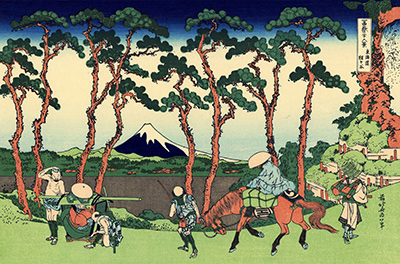Hokusai
Hodogaya on the Tokaido by Hokusai
Katsushika Hokusai is most renowned for his Mount Fuji series of works – with The Great Wave off Kanagawa being his most iconic piece. This study, Hodogaya on the Tokaido, is one of 36 pieces in the series produced by the artist and one of two impressions of the scene.
In this work Hokusai presents the viewer with a depiction of travellers on the Tokaido Highway as they pass through the route’s Hodogaya station. All but one of the travellers are heading west, looking weary from their climb of the Gonta-zaka hill. To the far left, the palanquin bearers take a rest and seem to be making themselves more comfortable after their exertions. To the far right of the image the lone walker heading east is typically dressed in a Buddhist monk’s travelling and climbing apparel – looking up at what appears to be a rock-carved traditional religious image.
The centre of the image is first of all dominated by Mount Fuji in the background, but, it is in the foreground that Hokusai uses his often applied imagery to challenge the viewer. The horse rider, white-hatted and cloaked in pale blue, is sat astride his steed with dropped head and tail. The parallels in shape and construct with the sacred mountain seem clear to many who have studied and commented on the work.
All of the travellers are concerned with their travels and travails except one. Looking directly at Mount Fuji, the man leading the rider’s horse seems to be gazing at the scene presented by the parting of the pine trees – perhaps pointing out the view with his stick to the rider or perhaps just in awe and wonder for himself.
A typical woodblock print in natural tones, Hokusai has a couple of other surprises for those looking on too. The blues and greens of the travellers’ clothing match perfectly with those in the leaves and sky to bring nature and life together. The clusters of pine needles meanwhile seem to be a reflection of the shape of the mountain to which the artist became so besotted with – perhaps in a plea for those studying the piece to do the same.
